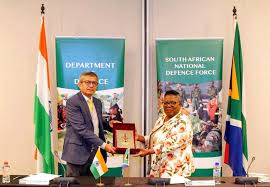India, South Africa sign pacts on submarine cooperation

In a major step toward bolstering maritime safety and strengthening bilateral defense ties, India and South Africa have signed a landmark agreement focused on submarine rescue operations. The deal underscores both nations’ growing collaboration in securing the Indian Ocean Region and highlights India’s emergence as a dependable maritime partner.
A New Chapter in Naval Collaboration
Signed in early September 2024, the Implementing Agreement on submarine rescue support was formalized between the Indian Navy and the South African Navy. The pact allows India to extend its Deep Submergence Rescue Vehicle (DSRV) capabilities to assist South African submarines in distress. This is particularly significant considering South Africa currently lacks an operational submarine rescue system.
The signing of this agreement follows the tragic 2023 incident involving the SAS Manthatisi, in which three South African Navy personnel lost their lives. The inability to respond effectively to that crisis sparked a reassessment of South Africa’s submarine emergency preparedness. With India stepping in to provide rapid-response support, both nations aim to prevent similar tragedies in the future.
India’s Submarine Rescue Expertise
India is one of the few countries in the region that possesses fully operational DSRVs, capable of deep-sea rescue missions up to 650 meters below sea level. These vehicles, acquired from the UK-based JFD (James Fisher Defence), are stationed on both coasts—Mumbai and Visakhapatnam—and are deployable via air, road, or sea. Each system includes a remotely operated vehicle (ROV), side-scan sonar, and support ships for coordinated deep-sea rescue operations.
These DSRVs are designed to rescue up to 14 personnel per dive, playing a vital role in reducing risk during underwater crises. India has already demonstrated its submarine rescue abilities internationally, most notably during the search for Indonesia’s KRI Nanggala submarine in April 2021. That mission boosted India’s global profile as a reliable provider of undersea rescue support.
Strategic Relevance in the Indian Ocean
The agreement comes at a time when the Indian Ocean is gaining strategic prominence. Both India and South Africa have vital interests in the region—ranging from maritime trade routes to undersea infrastructure and naval operations. A reliable submarine rescue framework adds an essential layer of operational safety, allowing both navies to deploy their fleets more confidently.
This pact reflects a shared commitment to regional security and the safeguarding of maritime assets. By leveraging India’s capabilities, South Africa can now operate its submarine fleet with a safety net in place—an essential factor in complex underwater missions.
Defense Diplomacy and Regional Stability
The submarine cooperation agreement also complements broader defense ties between the two nations. It builds on the 12th India–South Africa Navy Staff Talks held in August 2024, which addressed multiple areas including:
- Naval training and staff exchanges
- Nuclear, biological, and chemical (NBC) defense
- Joint diving support and special operations
- Continued collaboration in IBSAMAR—a trilateral naval exercise involving India, Brazil, and South Africa
India’s outreach to South Africa mirrors its agreements with other regional allies, including Singapore, where a similar pact on submarine rescue was signed in 2023. These efforts are part of India’s larger strategy to position itself as a maritime first responder in the Indo-Pacific.
Building Trust Through Capability Sharing
Submarine operations carry inherent risks, and without rescue options, these risks can quickly escalate into loss of life and equipment. The new agreement ensures that South African submariners are never alone in times of crisis. By offering a highly specialized service, India builds not only trust but also a deeper layer of interoperability between the two navies.
This capability-sharing also serves as a confidence-building measure. In a region where geopolitical tensions are simmering and maritime competition is increasing, such agreements act as stabilizers. They bring transparency, predictability, and shared responsibility to the maritime commons.
Symbol of India’s Global Naval Outreach
India’s growing readiness to share its naval capabilities—particularly high-end assets like DSRVs—signals a shift in its global defense posture. Rather than simply safeguarding its own assets, India is actively investing in collective maritime security.
This agreement with South Africa is another step in India’s effort to become a net security provider in the Indian Ocean and beyond. It aligns with its doctrine of SAGAR (Security and Growth for All in the Region) and enhances its diplomatic capital in multilateral maritime forums.
A Win-Win for Both Navies
For South Africa, the benefits are clear: enhanced safety for its submarine crews, access to advanced technology, and a boost in operational confidence. For India, the agreement consolidates its reputation as a leader in humanitarian and rescue missions, while fostering deeper strategic ties with a fellow Indian Ocean Rim nation.
It’s not just about equipment or logistics—it’s about shared values of cooperation, safety, and mutual support. This kind of defense diplomacy lays the groundwork for more complex collaborations in the future, whether in joint patrols, anti-piracy operations, or environmental monitoring missions.
Looking Ahead
As global security challenges continue to evolve, cooperation in areas like submarine rescue can no longer be viewed as optional—it’s a necessity. India and South Africa have recognized this imperative and responded with a pact that could serve as a model for other naval partnerships.
In an era where even a momentary delay can mean the difference between life and death underwater, having a reliable ally with advanced rescue systems is invaluable. This agreement is a reminder that true maritime strength lies not just in deterrence but in the ability to save lives when things go wrong.






